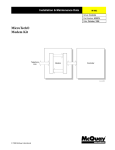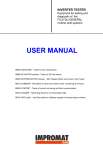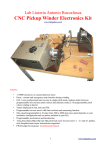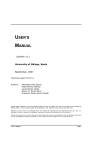Download Philips PM2505 User Manual
Transcript
MULTIMETER (analog) Click here to go to UPSCALE home page. Click here to go to I Year Lab home page. You can jump directly to a section of this specification sheet by selecting an item below and clicking the left button. ● ● ● Description of Apparatus Apparatus Specifications Instructions for use of Apparatus MULTIMETER (analog) Manufacturer: Philips (Netherlands) Model: PM 2505 Cost: $285 (1986) Description Versatile meter capable of measuring direct and alternating voltage on scales from 0.1 - 1000 V; direct and alternating current on scales from 1 uA - 10 A; resistance on 7 scales with midpoints 50 Ohms - 15 Meg-Ohms http://128.100.86.86/specs/pm2505.html (1 of 4)25/01/10 8:50:28 PM MULTIMETER (analog) Specifications Voltage Scales 0.1, 0.3, 1.0, 3.0, 10, 30, 100, 300, 1000 V Resistance 10 M-Ohms and 75 pF capacitance (all scales) Accuracy ±1.5% of full scale for dc voltages ±2.5% for ac 100mV - 1000V for 50/60 Hz ±5% for ac 100 mV - 300 V for 10 Hz - 30 kHz ±5% for ac on 1000 V scale for 10 Hz - 1 kHz Current Scales Accuracy 1, 3, 10, 30, 100 uA; 3, 10A. ±1.5% for dc, ±3% for ac AC Freq. ranges 10 Hz - 70 Hz for 1uA - 30 uA scales 10 Hz - 2 kHz for 100uA - 10 A scales Voltage drop (3 A scales) 31.6 mV on 1, 10, 100 uA, on 3, 100 mA (10 A scales) 100 mV on 3, 30, 300 uA, on 10, 300 mA 10 mV on 1, 30 mA, and 1A scales. Resistance Scales .1, .3, 1, 3, 10, 30, 100, 300, 1000 k-Ohms (and 3, 10, 30 M-Ohms full scale deflection) Accuracy ±3% of reading, near mid scale ±10% on 30 M-Ohm scale Click here to go to the top of this page. http://128.100.86.86/specs/pm2505.html (2 of 4)25/01/10 8:50:28 PM MULTIMETER (analog) Operating Instructions 1. Look to insure that the meter is at zero when turned off. If not, inform your Demonstrator. 2. Check the batteries: ❍ Switch the upper-right switch to the position labelled (approximately) " = ". ❍ Turn the rotary knob to the position labelled "+BATT(=)". ❍ Turn the meter on with the switch on the lower right of the instrument. ❍ The meter should be in the "Batt" region. If not, see your Demonstrator. ❍ Turn the rotary knob to the position with the picture of a loudspeaker and a label "-BATT (=)". ❍ The meter should still be in the "Batt" region. If not, see your Demonstrator. ❍ Turn the instrument off with the switch on the lower right of the instrument. 3. The desired meter function is selected by the switch on the upper right and the connections made to the meter on the left side of the case. The input labelled "0" is always connected and is ground. For voltage or resistance measurements the other lead is inserted in the input labelled with "V" and the Greek letter Omega; for currents up to 300 mA, the second lead is connected to the input labelled "uA - mA"; for currents greater than 300 mA the second lead is connected to the input labelled "A". 4. Rotate the dial to the highest possible scale for the measurement. 5. For resistance measurements, switch the upper-right selector to the position labelled with the Greek letter Omega, and turn the instrument on. 6. For voltage or current measurements, select AC or DC by switching the upper-right selector to the positions labelled (approximately) " ~ " or " = " respectively. Then turn the instrument on. 7. Rotate the knob to increase the sensitivity until you get the maximum possible deflection without going off the scale. 8. Multiply reading by the appropriate decade factor, determine polarity on the polarity meter. The red probe is at a positive potential with respect to the black probe when the polarity is indicated as +. Precautions ● ● ● Beware of improper probe insertion. Remember to turn off after using, but not between readings. Do not attempt resistance measurements in active circuits (power on). http://128.100.86.86/specs/pm2505.html (3 of 4)25/01/10 8:50:28 PM MULTIMETER (analog) Click here to go to the top of this page. keywords: ohmeter, ammeter, voltmeter, resistance measurement device, current measurement device, electrical measurement device, voltage measurement device. Document created circa 1986. Original author: Unknown. Last updated 08/01/96. Revised by David Harrison and Jaime Espinoza. http://128.100.86.86/specs/pm2505.html (4 of 4)25/01/10 8:50:28 PM








